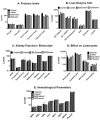Cumin Prevents 17β-Estradiol-Associated Breast Cancer in ACI Rats
- PMID: 34201250
- PMCID: PMC8228322
- DOI: 10.3390/ijms22126194
Cumin Prevents 17β-Estradiol-Associated Breast Cancer in ACI Rats
Abstract
Breast cancer (BC) is a leading cause of cancer deaths in women in less developed countries and the second leading cause of cancer death in women in the U.S. In this study, we report the inhibition of E2-mediated mammary tumorigenesis by Cuminum cyminum (cumin) administered via the diet as cumin powder, as well as dried ethanolic extract. Groups of female ACI rats were given either an AIN-93M diet or a diet supplemented with cumin powder (5% and 7.5%, w/w) or dried ethanolic cumin extract (1%, w/w), and then challenged with subcutaneous E2 silastic implants (1.2 cm; 9 mg). The first appearance of a palpable mammary tumor was significantly delayed by both the cumin powder and extract. At the end of the study, the tumor incidence was 96% in the control group, whereas only 55% and 45% animals had palpable tumors in the cumin powder and extract groups, respectively. Significant reductions in tumor volume (660 ± 122 vs. 138 ± 49 and 75 ± 46 mm3) and tumor multiplicity (4.21 ± 0.43 vs. 1.16 ± 0.26 and 0.9 ± 0.29 tumors/animal) were also observed by the cumin powder and cumin extract groups, respectively. The cumin powder diet intervention dose- and time-dependently offset E2-related pituitary growth, and reduced the levels of circulating prolactin and the levels of PCNA in the mammary tissues. Mechanistically, the cumin powder diet resulted in a significant reversal of E2-associated modulation in ERα, CYP1A1 and CYP1B1. Further, the cumin powder diet reversed the expression levels of miRNAs (miR-182, miR-375, miR-127 and miR-206) that were highly modulated by E2 treatment. We analyzed the composition of the extract by GC/MS and established cymene and cuminaldehyde as major components, and further detected no signs of gross or systemic toxicity. Thus, cumin bioactives can significantly delay and prevent E2-mediated mammary tumorigenesis in a safe and effective manner, and warrant continued efforts to develop these clinically translatable spice bioactives as chemopreventives and therapeutics against BC.
Keywords: ACI rats; Cuminum cyminum; breast cancer; cumin; estradiol.
Conflict of interest statement
The authors declare no conflict of interest.
Figures








References
-
- Howlader N., Noone A., Krapcho M., Miller D., Bishop K., Altekruse S.F., Kosary C.L., Yu M., Ruhl J., Tatalovich Z., et al., editors. SEER Cancer Statistics Review, 1975–2013. National Cancer Institute; Bethesda, MD, USA: [(accessed on 10 March 2021)]. Available online: http://seer.cancer.gov/csr/1975_2013/
MeSH terms
Substances
Grants and funding
LinkOut - more resources
Full Text Sources
Miscellaneous

